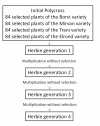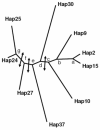Association study between the gibberellic acid insensitive gene and leaf length in a Lolium perenne L. synthetic variety
- PMID: 22204490
- PMCID: PMC3292539
- DOI: 10.1186/1471-2229-11-183
Association study between the gibberellic acid insensitive gene and leaf length in a Lolium perenne L. synthetic variety
Abstract
Background: Association studies are of great interest to identify genes explaining trait variation since they deal with more than just a few alleles like classical QTL analyses. They are usually performed using collections representing a wide range of variability but which could present a genetic substructure. The aim of this paper is to demonstrate that association studies can be performed using synthetic varieties obtained after several panmictic generations. This demonstration is based on an example of association between the gibberellic acid insensitive gene (GAI) polymorphism and leaf length polymorphism in 'Herbie', a synthetic variety of perennial ryegrass.
Methods: Leaf growth parameters, consisted of leaf length, maximum leaf elongation rate (LERmax) and leaf elongation duration (LED), were evaluated in spring and autumn on 216 plants of Herbie with three replicates. For each plant, a sequence of 370 bp in GAI was analysed for polymorphism.
Results: Genetic effect was highly significant for all traits. Broad sense heritabilities were higher for leaf length and LERmax with about 0.7 in each period and 0.5 considering both periods than for LED with about 0.4 in each period and 0.3 considering both periods. GAI was highly polymorphic with an average of 12 bp between two consecutive SNPs and 39 haplotypes in which 9 were more frequent. Linkage disequilibrium declined rapidly with distance with r 2 values lower than 0.2 beyond 150 bp. Sequence polymorphism of GAI explained 8-14% of leaf growth parameter variation. A single SNP explained 4% of the phenotypic variance of leaf length in both periods which represents a difference of 33 mm on an average of 300 mm.
Conclusions: Synthetic varieties in which linkage disequilibrium declines rapidly with distance are suitable for association studies using the "candidate gene" approach. GAI polymorphism was found to be associated with leaf length polymorphism which was more correlated to LERmax than to LED in Herbie. It is a good candidate to explain leaf length variation in other plant material.
Figures





Similar articles
-
Linkage disequilibrium in synthetic varieties of perennial ryegrass.Theor Appl Genet. 2007 Oct;115(6):837-47. doi: 10.1007/s00122-007-0612-3. Epub 2007 Aug 16. Theor Appl Genet. 2007. PMID: 17701396
-
Nucleotide diversity and linkage disequilibrium in 11 expressed resistance candidate genes in Lolium perenne.BMC Plant Biol. 2007 Aug 4;7:43. doi: 10.1186/1471-2229-7-43. BMC Plant Biol. 2007. PMID: 17683574 Free PMC article.
-
Leaf Rubisco turnover in a perennial ryegrass (Lolium perenne L.) mapping population: genetic variation, identification of associated QTL, and correlation with plant morphology and yield.J Exp Bot. 2013 Mar;64(5):1305-16. doi: 10.1093/jxb/ers384. J Exp Bot. 2013. PMID: 23505311
-
Natural variation of salinity response, population structure and candidate genes associated with salinity tolerance in perennial ryegrass accessions.Plant Cell Environ. 2013 Nov;36(11):2021-33. doi: 10.1111/pce.12112. Epub 2013 May 1. Plant Cell Environ. 2013. PMID: 23566156
-
Nucleotide diversity and linkage disequilibrium of nine genes with putative effects on flowering time in perennial ryegrass (Lolium perenne L.).Plant Sci. 2011 Feb;180(2):228-37. doi: 10.1016/j.plantsci.2010.08.015. Epub 2010 Aug 27. Plant Sci. 2011. PMID: 21421365
Cited by
-
Effects of Temperature on the Developmental and Reproductive Biology of North American Bean Thrips, Caliothrips fasciatus (Pergande) (Thysanoptera: Thripidae: Panchaetothripinae).Insects. 2023 Jul 15;14(7):641. doi: 10.3390/insects14070641. Insects. 2023. PMID: 37504647 Free PMC article.
-
LEAF-E: a tool to analyze grass leaf growth using function fitting.Plant Methods. 2014 Nov 6;10(1):37. doi: 10.1186/1746-4811-10-37. eCollection 2014. Plant Methods. 2014. PMID: 25435898 Free PMC article.
-
The effects of fluctuating temperatures on degree-day development and life history parameters of Pseudacysta perseae (Hemiptera: Tingidae).Ann Entomol Soc Am. 2025 Feb 10;118(2):160-172. doi: 10.1093/aesa/saaf008. eCollection 2025 Mar. Ann Entomol Soc Am. 2025. PMID: 40093986 Free PMC article.
-
Combining Drought Survival via Summer Dormancy and Annual Biomass Productivity in Dactylis glomerata L.Front Plant Sci. 2016 Feb 9;7:82. doi: 10.3389/fpls.2016.00082. eCollection 2016. Front Plant Sci. 2016. PMID: 26904054 Free PMC article.
-
Association analysis revealed loci linked to post-drought recovery and traits related to persistence of smooth bromegrass (Bromus inermis).PLoS One. 2022 Dec 7;17(12):e0278687. doi: 10.1371/journal.pone.0278687. eCollection 2022. PLoS One. 2022. PMID: 36477736 Free PMC article.
References
-
- Rafalski A. Application of single nucleotide polymorphisms in crop genetics. Curr Opin Plant Biol. 2002;54:94–100. - PubMed
MeSH terms
Substances
LinkOut - more resources
Full Text Sources

